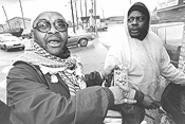Driving on an overcast February morning through Hough -- "the most popular place to get killed in Cuyahoga County" -- Thomas predicts a downpour. He's cruising the streets that almost killed him, with Billie Holiday on the tape deck and a bagful of oral AIDS tests in the backseat. As an outreach worker with Project SAFE, a program of the Cleveland Treatment Center (CTC), Thomas tries to reach drug addicts and others at risk for HIV before it's too late.
"I show them empathy," he says, plain and simple. "I show them that, not only can they recover, they can help others recover."
Thomas should know. During the 17 years he spent in prison, he explored the causes of his addiction, eventually becoming a certified chemical dependency counselor. He initially came to Project SAFE as a client, taking advantage of an opportunity offered through a prison prerelease center in 1987 to attend an HIV-education program. Even though he was doing it just to knock two days off his sentence, he got hooked.
Now he's one of the outreach workers who inspired him.
At a local drug treatment center for parolees, eager young men shake Thomas's hand and bask in his contagious optimism. In his bag today, in addition to HIV tests and condoms, he's carrying test results. One nervous man after another files through the door to an unheated office, where Thomas quickly gets down to business.
"Be glad the Lord don't want you today," he tells one relieved young man. To another, whose reported sex habits worry him, he urges a retest in three months. "Here's my card," he says. "It doesn't matter where you are, I'll come and test you."
Project SAFE ("Stay AIDS Free through Education") was formed in 1987 as a joint project of the City of Cleveland, CTC, Cleveland State University, and the Cuyahoga Drug Addiction Board, to gauge the effectiveness of one-on-one street outreach to intravenous drug users and their sex partners. By 1999, program workers had convinced 3,600 people to take AIDS tests, more than 50 percent of whom returned for post-test counseling sessions. Of those, 400 were referred for STD assessment and 100 for substance abuse treatment. In 1998 alone, Project SAFE was able to counsel 1,730 people, 1,553 of whom agreed to be tested for HIV. Of that number, 12 were diagnosed HIV-positive.
Testing has never been easier. There's no needles, just a swab (called a "lollipop") that test subjects hold between their cheek and gum for three minutes.
Project Director Willie Pace, who has been with the organization since its inception, says the program has changed with drug trends and the needs of its clients. To demonstrate, he summons three eager recruits, who file into his office with AIDS education materials in hand. The new outreach workers will be blanketing the West Side, he says, where IV-drug activity has been increasing lately.
"What's two things everyone has to know?" Pace quizzes.
"How to put on a condom," answers one. "How to clean syringes," says another.
"And how do you clean syringes?" Pace demands.
One of the new hires performs the cleaning ritual with an imaginary syringe. Although she hasn't used intravenous drugs, she explains the preferred method of cleaning syringes like a pro, the silver stud in her tongue glistening under the fluorescent lights. The veteran outreach workers -- who, like Thomas, are recovering addicts -- look impressed.
Most crack addicts don't come out until it gets dark, so Thomas usually spends his mornings talking to contacts in the neighborhoods -- proprietors of beauty parlors and barbershops and other small businesses. He refills fishbowls with free condoms and gives presentations to recovering addicts, parolees, and other groups at risk for HIV.
To Thomas, all women are "sisters," all men "big brothers." A devout Muslim, he doesn't bore people with recovery talk, though he occasionally does veer off into the spiritual realm. Wearing a white kufi on his head and toting a bag brimming with condoms, he's easy to spot. Usually, though, his clientele can hear him before they see him.
"Hum-du-Allah!" he shouts to a clump of young men on an otherwise deserted street. It means "All praises to God" and brings a smile to a depressed-looking ex-con, whom Thomas counseled after he did time for burglary.
"I'm going to Tri-C," the ex-con tells "Brother" Thomas, who gives him his blessing.
Cruising the inner-city streets, Thomas shares his encyclopedic knowledge of the impoverished East Side. He points out crack houses near East 90th and Hough, and heroin dens near Amor and Morison. He knows which stores front the drugs and which neighborhood churches turn their backs.
"It's about $10 for a hit of heroin out here," Thomas says. "And about $5 for a hit of crack. You can buy crack easier than something to eat."
He points out three mercurial youths standing like Fates in front of a store.
"They're selling crack," Thomas explains, sipping on a bottle of papaya juice. "One's got the gun. One's got the dope. And one's got the money. That way, if the cops come, you all run different ways."
Thomas explains this and other realities of the ghetto matter-of-factly, without any gratuitous belaboring. His voice only strains once -- when he talks of his 19-year-old son Marcus, who was shot to death last June for $1,000. His words couldn't stop the bullets that killed his son.
But they can stop HIV from killing the sons of others.
Hum-du-Allah.


